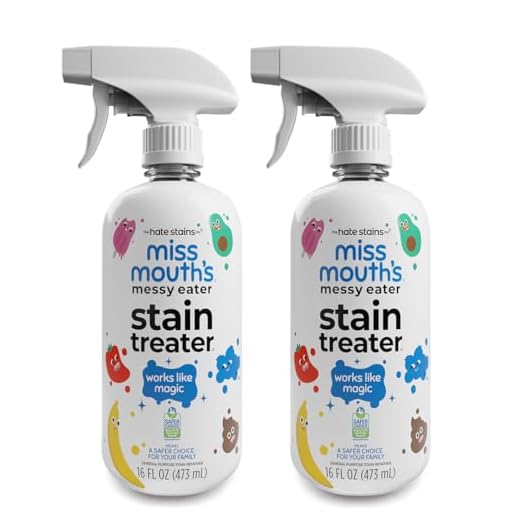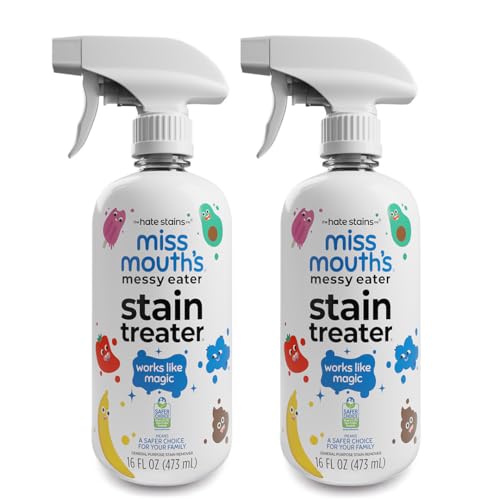



Act swiftly by applying cold water to the affected area. Ensure you blot the stain rather than rub it, as this will prevent further spreading. Use a clean cloth or paper towel, and dab gently until you’ve absorbed as much liquid as possible.
Next, mix a solution of mild dish soap and hydrogen peroxide. This combination has proven effective in breaking down the pigments that cause discoloration. Apply the mixture to the stain, allowing it to sit for approximately 30 minutes. Rinse thoroughly with cold water afterward.
If the mark persists, consider utilizing a specialized stain remover designed for tough spots. Follow the manufacturer’s instructions carefully to achieve optimal results. In cases of delicate materials, a patch test in an inconspicuous area is advisable before proceeding.
After treating, launder the item as per the care label instructions. Always check if the stain has been completely eliminated before placing the garment in a dryer, as heat can set the stain permanently.
Removing Stains from Textiles
Act quickly by blotting the area with a clean cloth to absorb excess liquid. Avoid rubbing, as this can push the pigment deeper into the fibers.
A combination of salt and cold water can help. Apply salt generously to the stain, allowing it to absorb the liquid. After a few minutes, rinse with cold water.
If salt isn’t available, a mixture of baking soda and water can work. Create a paste and apply it directly to the affected area. Let it sit for a short time before rinsing thoroughly.
For more stubborn marks, consider using white vinegar mixed with dish soap. Apply the solution, gently scrub with a soft brush, and rinse with cold water.
Pre-treating with a commercial stain remover before laundering can also enhance results. Follow the product instructions carefully for the best outcome.
Always test any cleaning solution on a hidden section of the material to ensure it won’t cause damage or discoloration. After treatment, wash the item as per its care label instructions.
Identify the Fabric Type Before Treatment
First, ascertain the composition of the material affected by the stain. Different textiles respond uniquely to cleaning methods, so knowing the type is fundamental for success. Here’s a breakdown of common fabric types and their characteristics:
| Fabric Type | Characteristics | Recommended Treatment |
|---|---|---|
| Cotton | Durable, absorbent, machine washable | Use cold water and mild detergent |
| Silk | Delicate, prone to damage, dry clean recommended | Blot with cold water, avoid rubbing |
| Wool | Warm, moisture-wicking, can shrink | Use a specialized wool cleaner, avoid hot water |
| Polyester | Strong, wrinkle-resistant, easy care | Cold water wash with standard detergent |
Testing for Colorfastness
Before applying any cleaning solution, conduct a colorfastness test. Apply a small amount of the chosen cleaner on an inconspicuous area. If the color remains intact, proceed with the stain removal process. If not, seek a gentler approach or consult a professional.
For a delicious recipe to complement your wine experience, check out this guide on how to cook lemon sole in the oven.
Immediate Steps to Take After Spilling
Act quickly; time is of the essence. The first action should involve gently dabbing the affected area with a clean cloth or paper towel. Avoid rubbing, as this can make the situation worse by pushing the liquid deeper into the fibers.
Blotting Technique
Use a blotting technique to absorb as much liquid as possible. Start from the outer edges of the stain and work inward to prevent spreading. Change the cloth frequently as it becomes saturated.
Cold Water Rinse
Next, rinse the stained section under cold running water. Ensure that the water flows through the back of the fabric to push the liquid out, rather than forcing it in further. This method helps dilute the pigment before applying any cleaning solution.
Once rinsed, lay the fabric flat on a clean, dry towel to absorb excess moisture. Avoid hanging it, as this might stretch the material and distort its shape.
After these initial steps, evaluate the fabric type and select an appropriate cleaning method for effective treatment.
Homemade Solutions for Stain Removal
Combine equal parts of white vinegar and dish soap, applying the mixture directly onto the affected area. Let it sit for approximately 30 minutes before blotting with a clean cloth.
Another option involves using club soda. Pour it over the stain and gently blot with a cloth. The carbonation helps lift the discoloration from the material.
Baking soda can serve as a powerful absorbent. Create a paste using baking soda and water, then apply it to the stained region. Allow it to dry completely before brushing off the residue.
A mixture of hydrogen peroxide and dish detergent in a 2:1 ratio can also be effective. Apply it to the mark, allowing it to penetrate the fibers for about 30 minutes, then rinse thoroughly.
For delicate textiles, a gentle solution of lemon juice and water may work well. Mix one part lemon juice with two parts water, apply, and rinse after a short period.
Always test any homemade remedy on a hidden area first to ensure it does not cause damage to the material.
Commercial Products That Work on Wine Stains
Consider using specialized stain removers designed for challenging discolorations. These products often contain enzymes and surfactants that target tannins effectively. Here are some highly regarded options:
- OxiClean MaxForce: This stain remover features a formula that tackles various stains, including those from beverages. Apply directly to the affected area and launder as instructed.
- Wine Away: A product specifically formulated for wine stains. It’s effective on both fresh and dried marks. Spray it on and blot until the stain lifts.
- Shout Advanced Gel: Known for its powerful stain-fighting capability, this gel penetrates fabric fibers. Apply it before washing for best results.
- Zout Laundry Stain Remover: This option includes a triple enzyme formula that breaks down stains. Treat the area before machine washing.
- Resolve Carpet Cleaner: If the spill occurs on carpet, this cleaner can be quite effective. Follow the instructions for optimal use.
Always conduct a patch test on an inconspicuous area before applying any product to ensure it won’t damage the material. Following the manufacturer’s instructions maximizes effectiveness while minimizing potential harm to the fabric.
Investing in these commercial products can save time and effort, providing a reliable solution for those unexpected spills.
Washing the Treated Material
After applying a stain treatment, it’s crucial to launder the material properly to ensure complete removal of any lingering marks and cleaning agents. Use cold water for rinsing initially, as hot water can set stains. Always follow the care label instructions specific to the textile.
Machine Washing
If the item is machine washable, select a gentle cycle with cold water. Add an appropriate amount of mild detergent, avoiding bleach or harsh chemicals. Always wash treated items separately to prevent any potential transfer of residues onto other garments.
Hand Washing
For delicate materials, hand washing is advisable. Fill a basin with cold water and a small amount of gentle detergent. Immerse the fabric, gently agitating it for several minutes. Rinse thoroughly under cold running water to remove all soap and any remaining treatment solution.
After washing, avoid wringing the fabric; instead, gently press the water out. Lay flat or hang to dry away from direct sunlight, as this can cause fading or damage to the fiber.
Once dry, inspect the area once more. If any trace of the stain remains, repeat the treatment process before laundering again. This approach maximizes the likelihood of complete stain removal.
Preventing Future Stains on Fabrics
To shield textiles from future blemishes, consider these strategies:
- Choose Stain-Resistant Fabrics: Opt for materials like microfiber, polyester, or treated cotton that resist absorption.
- Apply Fabric Protectors: Use sprays designed to repel liquids and stains. Follow manufacturer instructions for best results.
- Avoid Dark Colors: Lighter shades reveal spots more readily, while deeper hues may camouflage them, but they can also highlight other types of stains.
- Designate a Dining Area: Keep food and beverages in specific zones to minimize spills on upholstery and carpets.
- Use Coasters and Placemats: Always place drinks on coasters and use placemats for food to prevent direct contact with surfaces.
- Implement a “No Drinks” Rule: In high-risk areas, limit beverage consumption to reduce accident chances.
Regular maintenance plays a crucial role. Vacuum and clean surfaces often to prevent dirt accumulation and potential stains. If a spill occurs, act swiftly to treat it to avoid setting.







